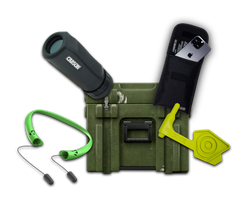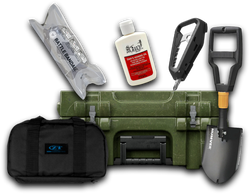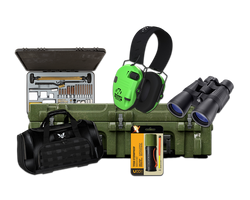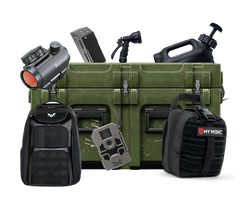How to Tie a Shemagh: A Comprehensive Guide for Tactical Enthusiasts
Table of Contents
- Introduction
- The History of the Shemagh
- Why You Should Use a Shemagh
- How to Tie a Shemagh: Step-by-Step Instructions
- Practical Uses of a Shemagh
- Choosing the Right Shemagh
- Conclusion
- FAQ
Introduction
Imagine you're navigating a harsh desert landscape, the sun beating down mercilessly while fine sand whips around you in a stinging whirlwind. In moments like these, the ability to shield yourself from the elements becomes not just a comfort, but a necessity. Enter the shemagh—a versatile scarf that has transcended its traditional Middle Eastern roots to become an essential piece of tactical gear for survivalists, outdoor enthusiasts, and military personnel alike.
The shemagh, also known as a keffiyeh or ghutrah, is a square piece of fabric, typically made of cotton, that can be worn in various styles to protect the head, face, and neck. Its origins date back centuries and are steeped in rich cultural history, but today, it is prized for its practicality in extreme conditions. This blog post aims to provide you with a detailed understanding of how to tie a shemagh, along with its myriad uses, from sun protection to first aid.
By the end of this guide, you'll not only know how to tie a shemagh effectively, but you'll also appreciate its value as a multi-functional tool in your tactical gear arsenal. We will explore various tying methods, practical applications, and tips for choosing the right shemagh for your needs.
The History of the Shemagh
Before diving into the techniques for tying a shemagh, it's essential to acknowledge its historical significance. Traditionally worn in the Middle East, the shemagh serves as a protective barrier against extreme weather conditions, including intense sunlight and harsh winds.
Historically, it has been adopted by various cultures and military forces around the world. British soldiers, for instance, have utilized the shemagh since World War II, appreciating its functionality in desert environments. Similarly, U.S. troops in Iraq and Afghanistan have come to rely on this practical garment for protection against sandstorms and sun exposure.
The shemagh’s design is not merely aesthetic; its utility is reflected in the choice of fabric and the size—typically around 42 inches by 42 inches—allowing it to be wrapped and tied in numerous ways to suit different purposes.
Why You Should Use a Shemagh
The shemagh's popularity in tactical circles stems from its versatility. Here are several reasons why incorporating a shemagh into your gear collection is a wise decision:
-
Protection from the Elements: It provides excellent protection against sunburn, wind, and dust.
-
Versatility: It can be used as a scarf, face mask, headwrap, or even a makeshift bag or tourniquet in emergencies.
-
Breathability: Cotton shemaghs allow for airflow, making them comfortable to wear in hot climates.
-
Compact and Lightweight: A shemagh can easily be rolled up and stored in a pack, ensuring it’s always accessible.
-
Fashionable and Functional: Beyond its practical applications, the shemagh has become a popular fashion accessory that can add a tactical flair to any outfit.
With these benefits in mind, let’s delve into the various styles for tying a shemagh.
How to Tie a Shemagh: Step-by-Step Instructions
1. Traditional Head and Face Wrap
The traditional head and face wrap is one of the most common methods for using a shemagh, especially in dusty or sunny conditions.
Steps to Follow:
- Fold the Shemagh: Start with the shemagh laid flat. Fold it in half diagonally to form a triangle.
- Position on Forehead: Place the folded edge of the triangle across your forehead, leaving the two ends hanging down.
- Wrap the Right Side: Bring the right end under your chin and wrap it across your shoulder to the back of your head.
- Wrap the Left Side: Pull the left side across your face, covering your nose and mouth.
- Tie the Ends: Bring both ends to the back of your head and tie them securely with an overhand knot. Adjust as needed to ensure comfort without compromising coverage.
This wrap style is excellent for protecting your face from dust while allowing you to adjust the coverage as necessary.
2. Tactical Head and Face Wrap
For those who require a bit more security, the tactical head and face wrap offers a more fitted approach.
Steps to Follow:
- Fold the Shemagh: As before, start by folding the shemagh diagonally.
- Drape Over Forehead: Position the folded edge across your forehead, ensuring one side is longer.
- Wrap the Shorter End: Take the shorter end and wrap it under your chin and up toward the back of your head.
- Cover the Face: With the longer end, pull it across your face, covering your mouth and nose.
- Secure the Wrap: Bring the longer end over your head, meeting the other end, and tie them together at the back with a firm knot.
This method provides maximum coverage and security, making it ideal for tactical situations or during heavy dust storms.
3. Loose Neck Scarf
For a more casual style that doesn’t cover the face, a loose neck scarf method is perfect for everyday wear.
Steps to Follow:
- Fold the Shemagh: Start with the shemagh flat and fold it diagonally.
- Position Over Face: Place the folded edge over your nose and mouth, allowing the ends to hang down.
- Wrap the Ends: Bring the ends over your shoulders and wrap them around the back of your neck.
- Tie the Ends: Secure with a loose knot at the back, allowing the ends to drape down.
This method is stylish while providing some protection against wind and cool weather.
4. Tidy Neck Scarf
For a more polished look, the tidy neck scarf method is a great option.
Steps to Follow:
- Fold the Shemagh: As before, fold the shemagh into a triangle.
- Wrap Across Face: Drape the folded edge over your nose and mouth.
- Cross the Ends: Bring the short ends over your shoulders and cross them at the back of your neck.
- Tie in Front: Bring the ends to the front and tie them at the center of your neck. Adjust to ensure a snug fit.
This style is not only functional but also fashionable, making it suitable for various casual outings.
5. Bandana Style
If you're looking for a simple and quick method, the bandana style is your best bet.
Steps to Follow:
- Fold the Shemagh: Open the shemagh fully and fold it diagonally into a triangle.
- Cover the Face: Place the triangle over your face, with the point down.
- Wrap and Tie: Bring the two loose ends to the back, wrap them around, and tie them securely.
This method is particularly useful for quick outings or moments when you need minimal coverage.
Practical Uses of a Shemagh
Beyond its function as a head and neck wrap, the shemagh can be employed in various practical scenarios:
- Dust Protection: Ideal for motorcycling or during outdoor activities in dusty environments.
- Warmth: A shemagh can be wrapped around your neck to provide warmth during cold weather.
- Emergency Bandage: In a pinch, it can serve as a bandage or sling for injuries.
- Water Filter: When folded properly, it can filter debris from water before boiling.
- Makeshift Bag: Lay it out, place items in the center, and tie the corners for a quick hobo sack.
- Towel: A shemagh can be used as a quick-drying towel after swimming or washing up.
The shemagh’s versatility is unmatched, making it a must-have item in your tactical gear collection.
Choosing the Right Shemagh
When selecting a shemagh, consider the following factors:
-
Material: Opt for 100% cotton for breathability and comfort. Synthetic fibers may not provide the same level of comfort in extreme conditions.
-
Size: Standard sizes range from 40x40 inches to 44x44 inches. Choose one that suits your intended use.
-
Color and Pattern: While practical, the color can also reflect personal style or tactical needs. Neutral colors can help with camouflage, whereas brighter colors may offer visibility in certain environments.
-
Weight: A lightweight shemagh is preferable for carrying in a pack, while a thicker one may offer more warmth in colder climates.
Conclusion
The shemagh is more than just a piece of fabric; it is a versatile tool that can significantly enhance your preparedness and comfort in various environments. Whether you're shielding against the sun, protecting yourself from dust, or needing a multi-use tool in a survival situation, mastering the art of tying a shemagh is an invaluable skill.
As a member of the Crate Club community, you have access to a range of high-quality tactical gear, including shemaghs that fit your needs. Explore our offerings through our Crate Club Subscription Services and check out the Crate Club Shop to equip yourself with the best gear available.
Encourage yourself and others to practice these tying methods and consider the many practical uses of a shemagh. What will you use your shemagh for next? Share your experiences with the community!
FAQ
Q: Can I use a shemagh in cold weather? A: Yes, a shemagh can be worn around the neck to provide warmth during colder months. It is effective in trapping heat while allowing breathability.
Q: Is there a specific way to wash a shemagh? A: Hand washing is recommended to preserve the fabric. Use cold water and mild detergent. Avoid bleach, which can damage the fabric.
Q: Can I wear a shemagh in a city environment? A: Absolutely! The shemagh can be a stylish accessory while also offering protection against pollution and weather.
Q: Are there any cultural considerations when wearing a shemagh? A: Yes, it’s important to respect the cultural significance of the shemagh. Be mindful of its historical context and wear it respectfully.
Q: How do I ensure my shemagh stays in place while moving? A: Tightly tying the ends and adjusting the fit will help keep the shemagh secure. Additionally, consider using accessories like goggles or hats to prevent slipping if needed.
By understanding how to tie a shemagh and recognizing its versatility, you'll be better prepared for whatever challenges come your way—whether in the wild, at the beach, or in everyday life.
Share this article



